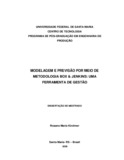| dc.creator | Kirchner, Rosane Maria | |
| dc.date.accessioned | 2007-05-28 | |
| dc.date.available | 2007-05-28 | |
| dc.date.issued | 2006-12-11 | |
| dc.identifier.citation | KIRCHNER, Rosane Maria. Modeling and forecast by means of Box & Jenkins methodology: a management tool. 2006. 64 f. Dissertação (Mestrado em Engenharia de Produção) - Universidade Federal de Santa Maria, Santa Maria, 2006. | por |
| dc.identifier.uri | http://repositorio.ufsm.br/handle/1/8325 | |
| dc.description.abstract | Independently of the company size it is necessary to establish goals, parameters and strategies. It is important to have guidance, a plan that conducts the actions for the
present as a way to reach the goals for the future. Moreover, the planning of the company requires organization, controls, tools which assist helpful favor the decisionmaking and the necessary reconducts. The modeling and consequently the forecast are indispensable tools for the management, such, proves it contribution of the Box & Jenkins methodology. The market is highly competitive and selective, demanding not
only efficiency, but mainly effectiveness. Actions directed to the magnifying of the quality of an organization are as important as the capacity to foresee, to know, to measure and to analyze the resolutivity of the used methodologies. In this context this present research is realized, searching to know the behavior of the company invoicing from an agricultural company and its two branch offices, molding and, in such a way, allowing putting into practice forecasts. Thus, the methodology applied consists of the use of historical data from the invoicing of the same ones. For the Main company, of Beta Company was found an ARMA(1,1) model, being this the most parsimonious. In CB Branch office the SARIMA (1,0,0) * (2,0,0) was the model that better described the data and in SL Branch office, the model SARIMA (1,0,0) *
(1,0,0). Realizing the forecast and comparing with the real data placed by the company, it was verified the efficiency of the model, being that all the values meet up with the confidence interval of 95%. Taking into base the results gained in this research, it is possible to affirm that the methodology used constitutes of an important tool, being able to be used by the managers of the respective companies,
supplying subsidies to the planning of the following months. | eng |
| dc.format | application/pdf | por |
| dc.language | por | por |
| dc.publisher | Universidade Federal de Santa Maria | por |
| dc.rights | Acesso Aberto | por |
| dc.subject | Gestão | por |
| dc.subject | Séries temporais | por |
| dc.subject | Modelagem | por |
| dc.subject | Box-Jenkins | por |
| dc.subject | Management | eng |
| dc.subject | Times series | eng |
| dc.subject | Modeling | eng |
| dc.subject | Box-Jenkins | eng |
| dc.title | Modelagem e previsão por meio de metodologia
Box & Jenkins: uma ferramenta de gestão | por |
| dc.title.alternative | Modeling and forecast by means of Box & Jenkins
methodology: a management tool | eng |
| dc.type | Dissertação | por |
| dc.description.resumo | Independentemente do tamanho da empresa é necessário estabelecer metas, parâmetros e estratégias. É importante ter um guia, um plano que direcione as ações do presente como meio de atingir as metas para o futuro. Além disso, o
planejamento da empresa requer organização, controles, ferramentas que auxilie e favoreça a tomada de decisões e redirecionamentos necessários. A modelagem e
consequentemente a previsão são ferramentas indispensáveis à gestão, para tal, evidencia-se a contribuição da metodologia Box & Jenkins. O mercado é altamente
competitivo e seletivo, exigindo não somente eficiência, mas principalmente eficácia. Ações direcionadas à ampliação da qualidade de uma organização são tão importantes quanto a capacidade de prever, conhecer, medir e analisar a
resolutividade das metodologias utilizadas. Neste contexto é que a presente investigação é realizada, buscando conhecer o comportamento do faturamento de uma empresa do ramo agrícola e de suas duas filiais, modelando e, realizando
previsões. Para tanto, a metodologia empregada consiste em utilizar dados históricos do faturamento das mesmas. Para a Matriz da Empresa Beta foi encontrado um modelo ARMA (1,1), sendo este o mais parcimonioso. Na Filial CB o modelo que melhor descreveu os dados foi o SARIMA (1,0,0)*(2,0,0) e na Filial SL o modelo SARIMA (1,0,0)*(1,0,0). Realizando a previsão e comparando com os dados reais disponibilizados pela empresa, verificou-se a eficiência do modelo, sendo que
todos os valores encontram-se no intervalo de confiança de 95%. Tomando-se por base os resultados obtidos nessa pesquisa, pode-se afirmar que a metodologia utilizada se constitui em uma importante ferramenta, podendo ser utilizada pelos gestores das respectivas empresas, fornecendo subsídios para o planejamento dos meses seguintes. | por |
| dc.contributor.advisor1 | Souza, Adriano Mendonça | |
| dc.contributor.advisor1Lattes | http://lattes.cnpq.br/5271075797851198 | por |
| dc.contributor.referee1 | Lopes, Luis Felipe Dias | |
| dc.contributor.referee1Lattes | http://lattes.cnpq.br/1074372911061770 | por |
| dc.contributor.referee2 | Silva, Wesley Vieira da | |
| dc.contributor.referee2Lattes | http://lattes.cnpq.br/1710286275396858 | por |
| dc.creator.Lattes | http://lattes.cnpq.br/7514722255908876 | por |
| dc.publisher.country | BR | por |
| dc.publisher.department | Engenharia de Produção | por |
| dc.publisher.initials | UFSM | por |
| dc.publisher.program | Programa de Pós-Graduação em Engenharia de Produção | por |
| dc.subject.cnpq | CNPQ::ENGENHARIAS::ENGENHARIA DE PRODUCAO | por |


